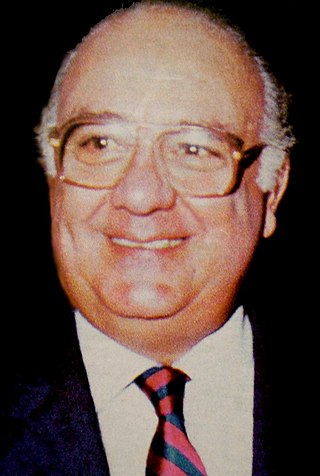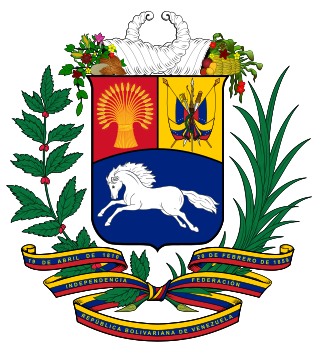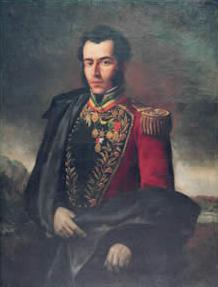
Marcos Evangelista Pérez Jiménez was a Venezuelan military and general officer of the Army of Venezuela and the dictator of Venezuela from 1950 to 1958, ruling as member of the military junta from 1950 to 1952 and as president from 1952 to 1958. He took part in the 1948 Venezuelan coup d'état, becoming part of the ruling junta. He ran in the 1952 election. However, the junta cancelled the election when early results indicated that the opposition was ahead, and declared Jiménez provisional president. He became president in 1953 and instituted a constitution that granted him dictatorial powers.

Rafael Antonio Caldera Rodríguez, twice elected the president of Venezuela, served for two five-year terms, becoming the longest serving democratically elected leader to govern the country in the twentieth century. His first term marked the first peaceful transfer of power to the opposition in Venezuela's history.

Juan Vicente Gómez Chacón was a Venezuelan military general, politician and de facto ruler of Venezuela from 1908 until his death in 1935. He was president on three occasions during this time, ruling through puppet governments in between.

Rómulo Ernesto Betancourt Bello, known as "The Father of Venezuelan Democracy", was the president of Venezuela, from 1945 to 1948 and again from 1959 to 1964, as well as leader of Acción Democrática, Venezuela's dominant political party in the 20th century.

Bolívar is one of the 23 states of Venezuela. The state capital city is Ciudad Bolívar and the largest city is Ciudad Guayana. Bolívar State covers a total surface area of 242,801 km2 (93,746 sq mi) and as of the 2011 census, had a population of 1,410,964. The state contains Angel Falls.

Ciudad Bolívar, formerly known as Angostura and St. Thomas de Guyana, is the capital of Venezuela's southeastern Bolívar State. It lies at the spot where the Orinoco River narrows to about 1 mile (1.6 km) in width, is the site of the first bridge across the river, and is a major riverport for the eastern regions of Venezuela.

Jaime Ramón Lusinchi was the president of Venezuela from 1984 to 1989. His term was characterized by an economic crisis, growth of the external debt, populist policies, currency depreciation, inflation and corruption that exacerbated the crisis of the political system established in 1958.

Ciudad Guayana is a city in Bolívar State, Venezuela. It stretches 40 kilometers along the south bank of the Orinoco river, at the point where it is joined by its main tributary, the Caroní river. The Caroní flows through the city from south to north, dividing it into its predominant halves — the old town of San Félix, to the east, and the newer area of Puerto Ordaz, to the west.

Ramón José Velásquez Mujica was a Venezuelan politician, historian, journalist, and lawyer. He served as the president of Venezuela between 1993 and 1994.

The Cabinet of Ministers of Venezuela (Spanish: Gabinete de Ministros de Venezuela is one of the bodies that make up the Venezuelan executive in that country's presidential system, alongside the Council of Ministers. The Cabinet is headed by the president of Venezuela, and his corresponding vice president. The purpose of the ministries is to create, adopt, follow and evaluate policies, strategies, programs and projects in accordance with the constitution and the laws of the republic.

The Central University of Venezuela is a public university located in Caracas, Venezuela. Founded in 1721, it is the oldest university in Venezuela and one of the oldest in the Western Hemisphere.

The Sucre family is a prominent political family of Venezuela.

The Republic of Venezuela was a democratic republic first established in 1953, and replaced in 1999 by the Bolivarian Republic of Venezuela. Venezuela saw ten years of military dictatorship from 1948 to 1958. After the 1948 Venezuelan coup d'état brought an end to a three-year experiment in democracy, a triumvirate of military personnel controlled the government until 1952, when it held presidential elections. These were free enough to produce results unacceptable to the government, leading them to be falsified and to one of the three leaders, Marcos Pérez Jiménez, assuming the Presidency. His government was brought to an end by the 1958 Venezuelan coup d'état, which saw the advent of democracy with a transitional government under Admiral Wolfgang Larrazábal in place until the December 1958 elections. Prior to the elections, three of the main political parties, Acción Democrática, COPEI and Unión Republicana Democrática, with the notable exclusion of the Communist Party of Venezuela, signed up to the Puntofijo Pact power-sharing agreement.
Corsicans, coming mainly from the regions of Cap Corse and La Castagniccia in the mediterranean island of Corsica, started arriving in the first third of the 19th century and settled mainly in the coastal towns of Carúpano and Rio Caribe. Known locally as Los Corsos, Corsicans played a central role in the development of the cocoa and rum industry in Venezuela. Around the 1950s many Corsican families left Paria and settled in Caracas, and have been active in politics, commerce, medicine and the arts.

The Caroní Municipality is one of the 11 municipalities (municipios) that makes up the Venezuelan state of Bolívar and, according to the 2011 census by the National Institute of Statistics of Venezuela, the municipality has a population of 704,585. The city of Guayana City is the shire town of the Caroní Municipality.
Franklin José Brito Rodríguez was a Venezuelan agricultural producer and biologist who gained national and international prominence over a land ownership dispute with the Venezuelan government's National Lands Institute INTI, which encouraged and allowed a neighboring farm owned by government supporters to invade and seize a large part of his land. He carried out a series of legal challenges and public protests from 2004, often coinciding with other protests such as the 2007 Venezuelan demonstrations. Brito's protests culminated in his death due to a hunger strike. Brito's death, which came in the highly charged pre-election atmosphere of the 2010 Venezuelan parliamentary election, led to widespread domestic and international media coverage.

Rómulo Betancourt won the 1958 Venezuelan general elections for Democratic Action and held the Presidency of Venezuela from February 13, 1959, to March 13, 1964. Betancourt started his second presidency as a moderate, except on the issue of dictatorships, instituting the idealistic foreign policy that Venezuela would not recognize dictatorial government anywhere, particularly in Latin America, but including the USSR. One significant domestic policy was land reform, with land largely from expropriated private landholdings redistributed to around 200,000 families.

The nations of Mexico and Venezuela established diplomatic relations in 1831, however, diplomatic relations between both nations have been historically unstable on several occasions. During the Venezuelan presidential crisis, Mexico took a neutral position and has continued to maintain diplomatic relations with the government of President Nicolás Maduro.
Óscar Raúl Celli Gerbasi was a Venezuelan politician and member of the Democratic Action (AD). Celli, who had previously served in the former Legislative Assembly of Carabobo, was appointed Governor of the Venezuelan state of Carabobo from 1985 until 1988 by President Jaime Lusinchi. He later became a deputy in the National Assembly.

Rectory Plaza, originally The Empty Plaza, is the name of a space located within the University City of Caracas, the campus of the Central University of Venezuela, in the San Pedro parish in the west of the city of Caracas.
















